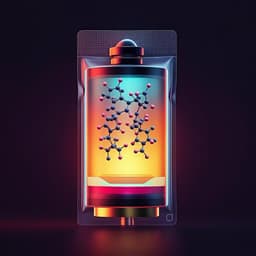
Engineering and Technology
Stable, high-performance, dendrite-free, seawater-based aqueous batteries
H. Tian, Z. Li, et al.
Discover how researchers Huajun Tian, Zhao Li, and their team tackled the challenges of metal anode instability in aqueous batteries. They propose an innovative strategy using Zn-Mn alloys, demonstrating impressive stability even in harsh conditions. This breakthrough could transform the future of aqueous battery technology!
Playback language: English
Introduction
Aqueous batteries offer a safer alternative to non-aqueous lithium-ion batteries due to the inherent safety of non-flammable electrolytes and their environmentally benign nature. Coupled with earth-abundant cathode materials, they hold the potential for high energy density, exceeding the 500 Wh kg⁻¹ needed for electric vehicles. However, significant challenges remain, primarily the inhomogeneous metal plating and electrochemical instability at the electrolyte/metal anode interface. This instability leads to dendrite growth, resulting in low Coulombic efficiency (CE), poor cyclability, and short circuits. While various strategies, such as structural optimization, surface modification, and artificial SEI layers, have been explored, progress in stabilizing metal anodes is still limited. Electrolyte chemistry also plays a crucial role. Deionized (DI) water is commonly used, but it is susceptible to hetero-ion interference that can negatively impact stability. While blended salts can improve performance, they are often less economically competitive. This research addresses these challenges by introducing a 3D alloy anode using low-cost seawater-based electrolytes. Instead of surface passivation, the strategy focuses on minimizing dendrite formation through thermodynamic control (favorable Zn diffusion on the Zn₃Mn alloy) and kinetic control (3D nanostructures). An in-situ optical visualization protocol, mimicking actual electrochemical conditions, was developed to directly observe the plating process. The study aims to demonstrate that this approach yields ultra-stable, dendrite-free electrodes, even under harsh conditions.
Literature Review
The literature extensively documents the challenges associated with metal anodes in aqueous batteries, particularly the formation of dendrites. Studies have explored various approaches to address this issue, including surface modifications, artificial SEI layers, and electrolyte engineering. Research highlights the importance of homogenous metal plating for achieving high Coulombic efficiency and long cycle life. Previous work demonstrated the potential of alloying to enhance anode stability and reduce dendrite formation in various battery systems. The use of seawater as an electrolyte has also been investigated, highlighting its economic advantages and environmental benefits. However, the complex composition of seawater poses challenges to battery stability due to the presence of hetero-ions, which need to be carefully managed. The existing literature provides a foundation for the current study, showing that a combined approach of materials design and electrolyte engineering is crucial for overcoming the limitations of aqueous metal-anode batteries.
Methodology
This study employed a three-pronged methodology involving materials synthesis, electrochemical characterization, and in-situ visualization. First, 3D structured Zn-Mn alloy anodes were synthesized via an alloy electrodeposition approach. This method is adaptable for various alloy compositions by adjusting parameters like the composition of the deposition solution, current/voltage, and deposition time. The study focused on Zn-Mn alloys to validate the concept, with the electrochemical performance of the Zn-Mn anode evaluated in detail. The use of a high current density (0.3 A cm⁻²) during electrodeposition facilitated the formation of 3D structures using hydrogen bubbles as templates, creating a cauliflower-like morphology. The resulting Zn-Mn alloy was characterized using XRD, EDS, AFM, and HRTEM to confirm its composition and structure. Surface wettability was assessed using contact angle goniometry, revealing the superhydrophilic nature of the 3D Zn₃Mn anode, promoting better electrolyte contact. DFT calculations were used to investigate the binding energy of Zn atoms on the Zn₃Mn surface, providing insights into the thermodynamics of Zn nucleation and growth. Electrochemical stability was evaluated using different aqueous electrolytes, including seawater-based electrolytes. A three-electrode electrochemical cell with Pt as the working electrode, and Zn₃Mn alloy as counter and reference electrodes, was used to study Zn plating/stripping reversibility and electrochemical window. The Coulombic efficiency was assessed via Cu//Zn and Cu//Zn-Mn cells. Electrochemical impedance spectroscopy (EIS) was employed to study charge transfer kinetics. In-situ optical visualization was performed using a specially designed protocol, enabling direct observation of Zn plating/stripping processes under different conditions. A 2D and 3D finite element analysis using COMSOL Multiphysics was used to simulate the plating profile and thickness change on the Zn-Mn alloy. To demonstrate practical application, Zn-air batteries (ZABs) and Zn-ion batteries (ZIBs) were assembled using the Zn-Mn alloy anode and various cathodes. The electrochemical performance of these batteries was evaluated under various conditions, including high current densities and flexible configurations. Ex-situ X-ray absorption spectroscopy (XAS) was employed to investigate the structural changes in the electrodes during charge/discharge cycles.
Key Findings
The study demonstrated the successful fabrication of a 3D Zn-Mn alloy anode with a unique cauliflower-like structure and high surface area. Characterization confirmed the formation of the Zn₃Mn alloy phase. The 3D Zn₃Mn anode exhibited superhydrophilicity (contact angle of 0°), significantly enhancing electrolyte contact. DFT calculations revealed a higher binding energy for Zn atoms on the Zn₃Mn surface (1.42 eV) compared to pure Zn (1.12 eV), promoting uniform Zn deposition and suppressing dendrite formation. The Zn₃Mn anode demonstrated exceptional stability and high Coulombic efficiency (nearly 100%) even in seawater-based electrolytes, withstanding a high current density of 80 mA cm⁻² for over 1900 cycles. In contrast, the pristine Zn anode failed after only 80 cycles under the same conditions. The in-situ optical visualization protocol, coupled with COMSOL simulations, provided direct evidence of the uniform Zn deposition within the 3D structure, effectively suppressing dendrite formation. The Zn-Mn alloy anode showed superior performance in both ZABs and ZIBs, significantly outperforming devices using pristine Zn anodes. ZABs with the Zn₃Mn anode exhibited high discharge capacity (816.3 mAh gZn⁻¹) and energy density (798.3 Wh kgZn⁻¹). Flexible ZABs using the Zn₃Mn anode displayed robust stability and functionality even under repeated twisting. ZIBs with the Zn₃Mn anode showed higher capacity and discharge voltage plateaus compared to ZIBs with a pristine Zn anode. Ex-situ XAS analysis confirmed the reversible intercalation of Zn²⁺ into the MnO₂ cathode and the stability of the Zn₃Mn anode during cycling. The Zn₃Mn anode also demonstrated excellent anti-interference properties against hetero-ions (Na⁺, Mg²⁺, Ca²⁺, and Cl⁻) present in the seawater electrolyte.
Discussion
The findings directly address the research question of developing stable, high-performance aqueous batteries by demonstrating the effectiveness of the proposed 3D Zn-Mn alloy anode design. The superior performance of the Zn-Mn alloy compared to pristine Zn anodes highlights the critical role of alloying and 3D architecture in suppressing dendrite formation and enhancing stability. The high Coulombic efficiency, long cycle life, and high energy density achieved in ZABs and ZIBs demonstrate the potential of this technology for practical applications. The use of seawater as an electrolyte significantly reduces costs and environmental impact. The in-situ visualization protocol is a crucial advancement, providing invaluable insights into the electrodeposition mechanism and confirming the uniformity of Zn deposition. The successful demonstration of anti-interference properties against hetero-ions in seawater suggests that the technology is robust and adaptable to real-world conditions. The overall significance of this work lies in its potential to revolutionize the design of high-performance anodes for aqueous batteries and broader implications for renewable energy storage.
Conclusion
This study successfully demonstrated a universal strategy for designing stable, high-performance, and dendrite-free aqueous batteries using 3D Zn-Mn alloy anodes and seawater-based electrolytes. The combined control of thermodynamics and reaction kinetics, coupled with the use of in-situ visualization, provided critical insights into the mechanism of dendrite suppression. The exceptional performance of the Zn-Mn anode in both ZABs and ZIBs highlights its potential for practical applications. Future research should explore other alloy compositions and 3D architectures to further enhance battery performance and explore the scalability and manufacturability of this technology.
Limitations
While the study demonstrates excellent performance under specific conditions, further investigation is needed to assess the long-term stability and performance under varying temperature and operating conditions. The current study primarily focused on Zn-Mn alloys; future studies should explore the applicability of this design strategy to other alloy systems. The in-situ optical visualization technique, while effective, might not capture the very early stages of nucleation due to resolution limitations. A more comprehensive cost-benefit analysis considering scalability and manufacturing processes is also warranted.
Related Publications
Explore these studies to deepen your understanding of the subject.







